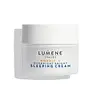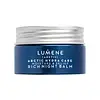What's inside
What's inside
 Key Ingredients
Key Ingredients

 Benefits
Benefits

 Concerns
Concerns

 Ingredients Side-by-side
Ingredients Side-by-side

Water
Skin ConditioningPrunus Amygdalus Dulcis Oil
Skin ConditioningHydrogenated Polydecene
EmollientOlus Oil
EmollientGlycerin
HumectantCetearyl Alcohol
EmollientLactococcus Ferment Lysate
Skin ConditioningOctyldodecyl Myristate
EmollientOleyl Erucate
EmollientCetyl Palmitate
EmollientGlyceryl Stearate
EmollientNiacinamide
SmoothingPEG-100 Stearate
Rubus Chamaemorus Seed Oil
Skin ConditioningRubus Chamaemorus Seed Extract
Skin ConditioningPhenoxyethanol
PreservativeHydrogenated Olive Oil
Skin ConditioningCetearyl Glucoside
EmulsifyingPropylheptyl Caprylate
EmollientTocopheryl Acetate
AntioxidantOlea Europaea Fruit Oil
MaskingPropanediol
SolventHippophae Rhamnoides Oil
EmollientAcrylates/C10-30 Alkyl Acrylate Crosspolymer
Emulsion StabilisingEthylhexylglycerin
Skin ConditioningAllantoin
Skin ConditioningOlea Europaea Oil Unsaponifiables
Skin ConditioningLecithin
EmollientTocopherol
AntioxidantPEG-8
HumectantXanthan Gum
EmulsifyingCaprylyl Glycol
EmollientMagnesium Ascorbyl Phosphate
AntioxidantRetinyl Palmitate
Skin ConditioningAlgae Extract
EmollientSodium Hyaluronate
HumectantLactic Acid
BufferingSodium Hydroxide
BufferingSodium Benzoate
MaskingSodium Chloride
MaskingAscorbyl Palmitate
AntioxidantPotassium Sorbate
PreservativeGlucose
HumectantAscorbic Acid
AntioxidantChondrus Crispus
MaskingCitric Acid
BufferingHelianthus Annuus Seed Oil
EmollientRosmarinus Officinalis Leaf Extract
AntimicrobialChondrus Crispus Extract
Skin ConditioningLimonene
PerfumingLinalool
PerfumingCitral
PerfumingParfum
MaskingWater, Prunus Amygdalus Dulcis Oil, Hydrogenated Polydecene, Olus Oil, Glycerin, Cetearyl Alcohol, Lactococcus Ferment Lysate, Octyldodecyl Myristate, Oleyl Erucate, Cetyl Palmitate, Glyceryl Stearate, Niacinamide, PEG-100 Stearate, Rubus Chamaemorus Seed Oil, Rubus Chamaemorus Seed Extract, Phenoxyethanol, Hydrogenated Olive Oil, Cetearyl Glucoside, Propylheptyl Caprylate, Tocopheryl Acetate, Olea Europaea Fruit Oil, Propanediol, Hippophae Rhamnoides Oil, Acrylates/C10-30 Alkyl Acrylate Crosspolymer, Ethylhexylglycerin, Allantoin, Olea Europaea Oil Unsaponifiables, Lecithin, Tocopherol, PEG-8, Xanthan Gum, Caprylyl Glycol, Magnesium Ascorbyl Phosphate, Retinyl Palmitate, Algae Extract, Sodium Hyaluronate, Lactic Acid, Sodium Hydroxide, Sodium Benzoate, Sodium Chloride, Ascorbyl Palmitate, Potassium Sorbate, Glucose, Ascorbic Acid, Chondrus Crispus, Citric Acid, Helianthus Annuus Seed Oil, Rosmarinus Officinalis Leaf Extract, Chondrus Crispus Extract, Limonene, Linalool, Citral, Parfum
Water
Skin ConditioningGlycerin
HumectantButyrospermum Parkii Butter
Skin ConditioningOleyl Erucate
EmollientPropanediol
SolventCanola Oil
EmollientMyristyl Myristate
EmollientShea Butter Ethyl Esters
EmollientBetaine
HumectantVaccinium Myrtillus Fruit Juice
Skin ConditioningC12-16 Alcohols
EmollientCetyl Alcohol
EmollientGlyceryl Stearate
EmollientAvena Sativa Kernel Oil
Skin ConditioningHydrogenated Oat Kernel Oil
EmollientVaccinium Myrtillus Seed Oil
Skin ConditioningHydrogenated Lecithin
EmulsifyingPalmitic Acid
EmollientTocopherol
AntioxidantPhenoxyethanol
PreservativeSaccharide Isomerate
HumectantHelianthus Annuus Seed Oil
EmollientSodium Lauroyl Lactylate
EmulsifyingCetyl Hydroxyethylcellulose
Emulsion StabilisingSclerotium Gum
Emulsion StabilisingSodium Gluconate
Skin ConditioningEthylhexylglycerin
Skin ConditioningCeramide NP
Skin ConditioningCeramide AP
Skin ConditioningPhytosphingosine
Skin ConditioningCholesterol
EmollientCitric Acid
BufferingSodium Citrate
BufferingSodium Carrageenan
Emulsion StabilisingXanthan Gum
EmulsifyingCarbomer
Emulsion StabilisingMaris Sal
Skin ConditioningRosmarinus Officinalis Leaf Extract
AntimicrobialCeramide EOP
Skin ConditioningWater, Glycerin, Butyrospermum Parkii Butter, Oleyl Erucate, Propanediol, Canola Oil, Myristyl Myristate, Shea Butter Ethyl Esters, Betaine, Vaccinium Myrtillus Fruit Juice, C12-16 Alcohols, Cetyl Alcohol, Glyceryl Stearate, Avena Sativa Kernel Oil, Hydrogenated Oat Kernel Oil, Vaccinium Myrtillus Seed Oil, Hydrogenated Lecithin, Palmitic Acid, Tocopherol, Phenoxyethanol, Saccharide Isomerate, Helianthus Annuus Seed Oil, Sodium Lauroyl Lactylate, Cetyl Hydroxyethylcellulose, Sclerotium Gum, Sodium Gluconate, Ethylhexylglycerin, Ceramide NP, Ceramide AP, Phytosphingosine, Cholesterol, Citric Acid, Sodium Citrate, Sodium Carrageenan, Xanthan Gum, Carbomer, Maris Sal, Rosmarinus Officinalis Leaf Extract, Ceramide EOP
Ingredients Explained
These ingredients are found in both products.
Ingredients higher up in an ingredient list are typically present in a larger amount.
Citric Acid is an alpha hydroxy acid (AHA) naturally found in citrus fruits like oranges, lemons, and limes.
Like other AHAs, citric acid can exfoliate skin by breaking down the bonds that hold dead skin cells together. This helps reveal smoother and brighter skin underneath.
However, this exfoliating effect only happens at high concentrations (20%) which can be hard to find in cosmetic products.
Due to this, citric acid is usually included in small amounts as a pH adjuster. This helps keep products slightly more acidic and compatible with skin's natural pH.
In skincare formulas, citric acid can:
While it can provide some skin benefits, research shows lactic acid and glycolic acid are generally more effective and less irritating exfoliants.
Most citric acid used in skincare today is made by fermenting sugars (usually from molasses). This synthetic version is identical to the natural citrus form but easier to stabilize and use in formulations.
Read more about some other popular AHA's here:
Learn more about Citric AcidEthylhexylglycerin (we can't pronounce this either) is commonly used as a preservative and skin softener. It is derived from glyceryl.
You might see Ethylhexylglycerin often paired with other preservatives such as phenoxyethanol. Ethylhexylglycerin has been found to increase the effectiveness of these other preservatives.
Glycerin is already naturally found in your skin. It helps moisturize and protect your skin.
A study from 2016 found glycerin to be more effective as a humectant than AHAs and hyaluronic acid.
As a humectant, it helps the skin stay hydrated by pulling moisture to your skin. The low molecular weight of glycerin allows it to pull moisture into the deeper layers of your skin.
Hydrated skin improves your skin barrier; Your skin barrier helps protect against irritants and bacteria.
Glycerin has also been found to have antimicrobial and antiviral properties. Due to these properties, glycerin is often used in wound and burn treatments.
In cosmetics, glycerin is usually derived from plants such as soybean or palm. However, it can also be sourced from animals, such as tallow or animal fat.
This ingredient is organic, colorless, odorless, and non-toxic.
Glycerin is the name for this ingredient in American English. British English uses Glycerol/Glycerine.
Learn more about GlycerinGlyceryl Stearate is a mix of glycerin and stearic acid.
It is used to stabilize the mixing of water and oil ingredients. By preventing these ingredients from separating, it can help elongate shelf life. It can also help thicken the product's texture.
As an emollient, it helps soften skin and supports barrier-replenishing ingredients.
In cosmetics, Glyceryl Stearate is often made from vegetable oils or synthetically produced.
This ingredient may not be fungal-acne safe
Fun fact: The human body also creates Glyceryl Stearate naturally.
Learn more about Glyceryl StearateHelianthus Annuus Seed Oil is the oil derived from the seeds of a Sunflower. Sunflower seed oil is non-fragrant. It is an emollient, meaning it helps to soften the skin.
Sunflower seed oil contains many fatty acids. The fatty acids found in sunflower seeds include (from highest amount to least): linoleic acid, myristic acid, palmitic acid, stearic acid, arachidic acid, oleic acid, and linolenic acid.
These fatty acids help the skin create ceramides. Ceramides play a role in repairing the skin barrier.
Helianthus Annuus Seed Oil helps moisturize the skin. This in turn helps the skin look more rejuvenated and smoother.
Sunflowers are rich in vitamin E.
Historians believe Indigenous cultures of North America domesticated sunflowers before corn. Thus they relied on sunflower oil for a variety of uses. One such use is moisturizing skin and hair.
Sunflower seed oil may not be fungal acne safe. We recommend speaking with a professional if you have any concerns.
Learn more about Helianthus Annuus Seed OilOleyl Erucate is created from oleyl alcohol and erucic acid. It mainly functions as an emollient.
Emollients help soften and hydrate the skin by forming a lightweight film on skin that reduces water loss and improves feel.
In some cases, Oleyl Erucate is used as a solvent or dispersing agent to help make formulations easier to spread.
This ingredient may not be fungal acne safe.
Learn more about Oleyl ErucatePhenoxyethanol is a preservative that has germicide, antimicrobial, and aromatic properties. Studies show that phenoxyethanol can prevent microbial growth. By itself, it has a scent that is similar to that of a rose.
It's often used in formulations along with Caprylyl Glycol to preserve the shelf life of products.
Propanediol is an all-star ingredient. It softens, hydrates, and smooths the skin.
It’s often used to:
Propanediol is not likely to cause sensitivity and considered safe to use. It is derived from corn or petroleum with a clear color and no scent.
Learn more about PropanediolRosmarinus Officinalis Leaf Extract comes from rosemary. Rosemary is native to the Mediterranean.
While Rosmarinus Officinalis Leaf Oil can be volatile due to its fragrant properties, the fragrance components are usually removed in the leaf extract.
Rosemary Leaf Extract contains many antioxidants such as rosmarinic acid and caffeic acid. Rosemarinic acid, a compound found in rosemary leaf, has been found to help soothe skin conditions such as eczema and acne.
Learn more about Rosmarinus Officinalis Leaf ExtractTocopherol (also known as Vitamin E) is a common antioxidant used to help protect the skin from free-radicals and strengthen the skin barrier. It's also fat soluble - this means our skin is great at absorbing it.
Vitamin E also helps keep your natural skin lipids healthy. Your lipid skin barrier naturally consists of lipids, ceramides, and fatty acids. Vitamin E offers extra protection for your skin’s lipid barrier, keeping your skin healthy and nourished.
Another benefit is a bit of UV protection. Vitamin E helps reduce the damage caused by UVB rays. (It should not replace your sunscreen). Combining it with Vitamin C can decrease sunburned cells and hyperpigmentation after UV exposure.
You might have noticed Vitamin E + C often paired together. This is because it is great at stabilizing Vitamin C. Using the two together helps increase the effectiveness of both ingredients.
There are often claims that Vitamin E can reduce/prevent scarring, but these claims haven't been confirmed by scientific research.
Learn more about TocopherolWater. It's the most common cosmetic ingredient of all. You'll usually see it at the top of ingredient lists, meaning that it makes up the largest part of the product.
So why is it so popular? Water most often acts as a solvent - this means that it helps dissolve other ingredients into the formulation.
You'll also recognize water as that liquid we all need to stay alive. If you see this, drink a glass of water. Stay hydrated!
Learn more about WaterXanthan gum is used as a stabilizer and thickener within cosmetic products. It helps give products a sticky, thick feeling - preventing them from being too runny.
On the technical side of things, xanthan gum is a polysaccharide - a combination consisting of multiple sugar molecules bonded together.
Xanthan gum is a pretty common and great ingredient. It is a natural, non-toxic, non-irritating ingredient that is also commonly used in food products.
Learn more about Xanthan Gum